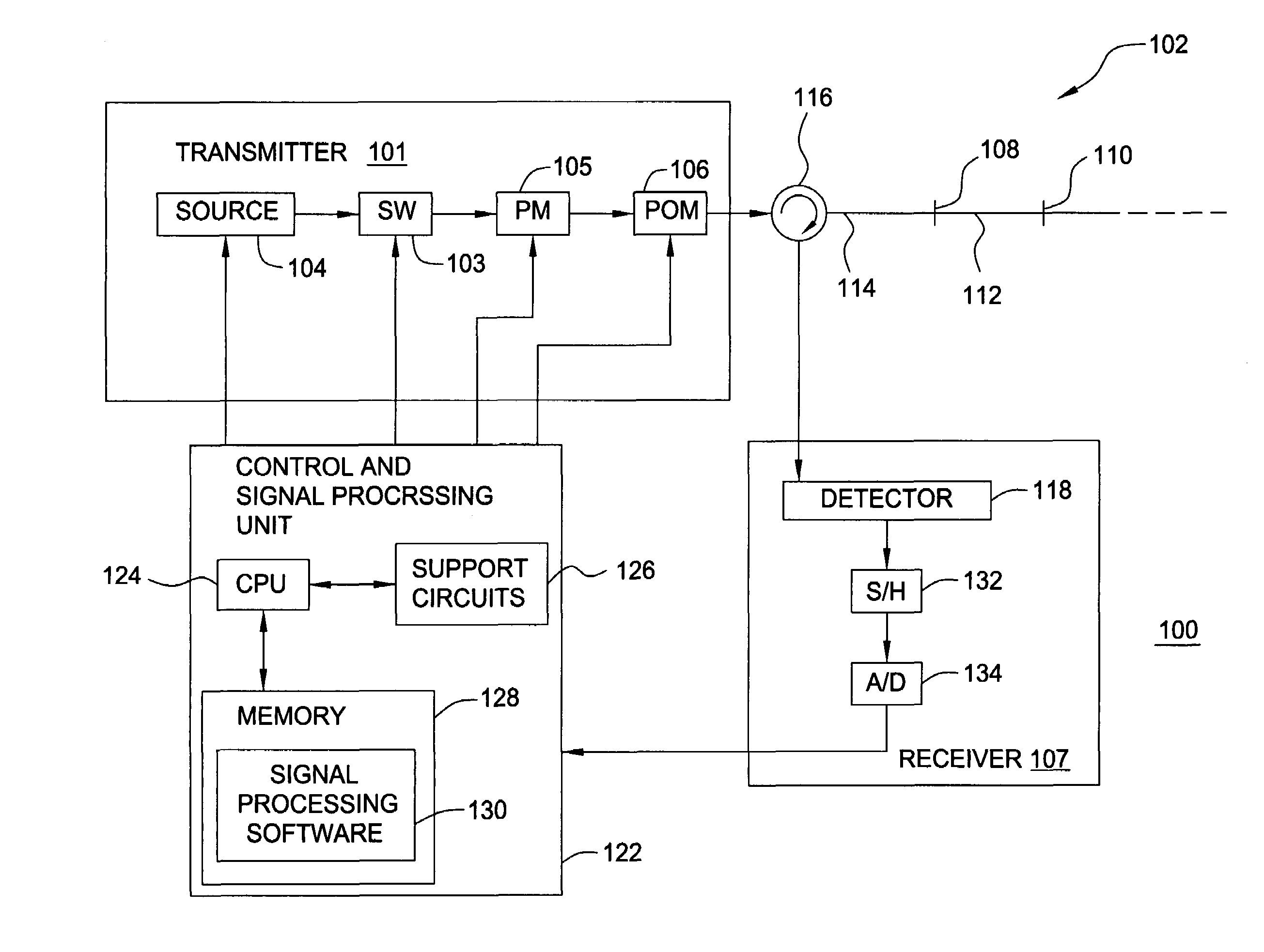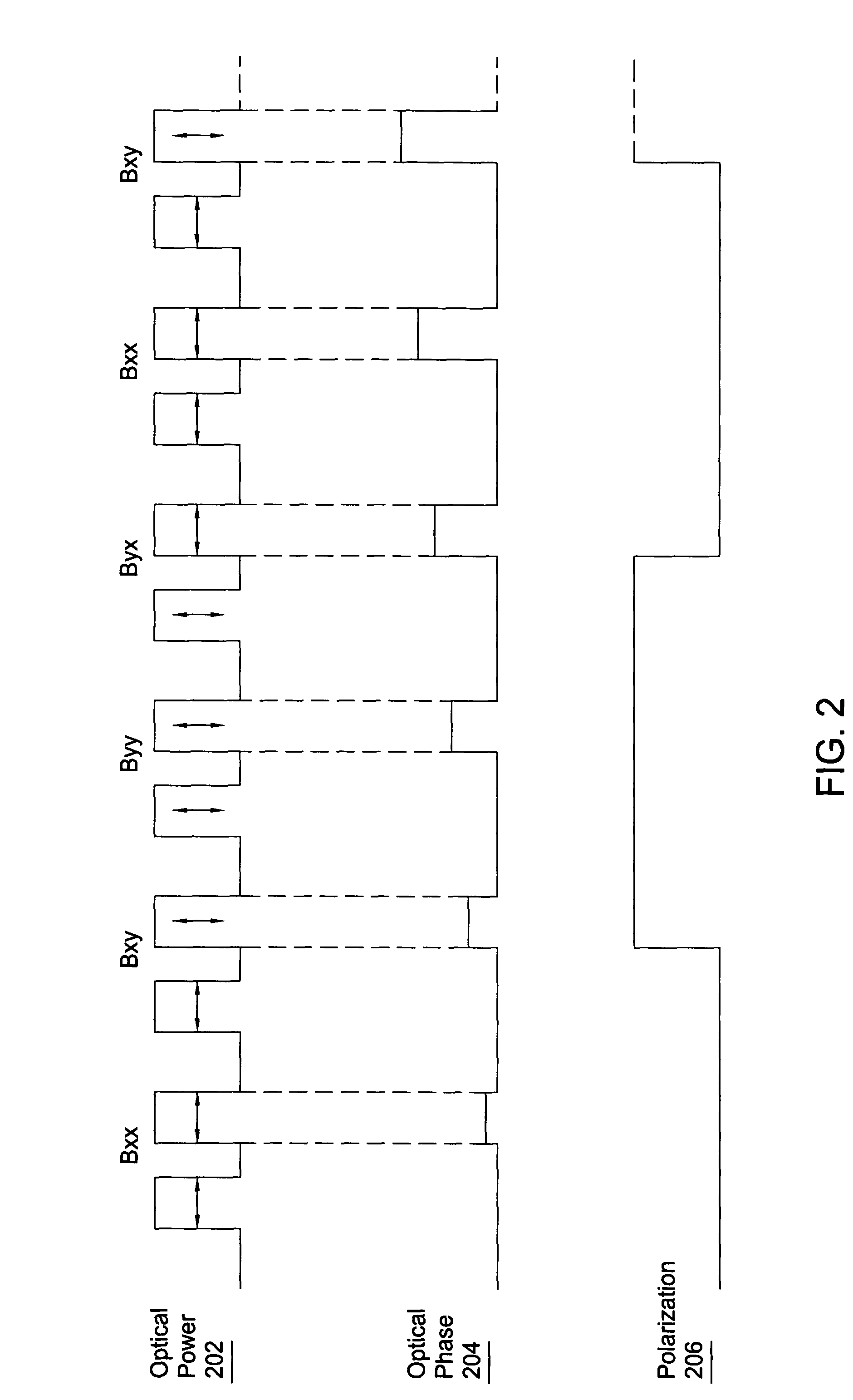Method and apparatus for providing polarization insensitive signal processing for interferometric sensors
a technology of interferometer and signal processing, applied in the field of interferometer, can solve the problems of fiber inducing phase noise, imbalance equal to the difference in time-delay experienced, and unbalanced interferometer
- Summary
- Abstract
- Description
- Claims
- Application Information
AI Technical Summary
Benefits of technology
Problems solved by technology
Method used
Image
Examples
first embodiment
[0030]FIG. 1 depicts the present invention incorporated into an optical interferometer sensor system 100. The optical interferometer sensor system 100 comprises a transmitter 101, a receiver 107, an optical circulator 116, a sensor array 102, and a control and signal processing unit 122. The transmitter 101 comprises a source 104, a Mach-Zender switch 103, a phase modulator 105 and a polarization modulator 106. The receiver 107 comprises a detector 118, a sample-and-hold (S / H) circuit 132 and an analog-to-digital (A / D) converter 134. The source 104 is a light source such as a laser. The light from the source 104 is pulsed by switch 103, phase modulated by phase modulator 105 and polarization modulated by the modulator 106 to form polarization-induced phase noise insensitive interrogation pulses as described below. Preferably, the fibers that interconnect components within the transmitter should be polarization maintaining fibers so that the polarization into the polarization modulat...
second embodiment
[0067]In an alternative version of the second embodiment, the two polarization modulators 304 in FIG. 3 can be used to set the source polarization states in four subsequent measurements to four linearly independent Stokes vectors Sk=└S0k,S1kS2k,S3k┘, k=1, . . . ,4. As an example, if TDM is used, four subsequent interrogation pulse pairs can have horizontal, vertical, 45° linear and right circular polarization states. These states represent four linearly independent Stokes vectors, and matrix R can be found using Equation (14). Although, this choice of transmitter output SOPs might be the preferred embodiment, any four polarization states that can be represented by four linear independent polarization states can be used. This method can also be applied to systems that do not employ TDM, such as WDM or FDM systems or other systems that employ a continuous wave source. In this case the source polarization should be switched between the four polarization states at a rate that is at leas...
third embodiment
[0076]In second version of the third embodiment three-way optical splitter 406 is replaced by a four-way optical splitter, and polarizers with output to only one detector each is used. The power in one of the outputs of the splitter is measured without a polarizer before the detector. This projection is represented by Stokes vector [1,0,0,0]. The three other outputs may project the incoming light to splitter into horizontal(H) SOP, linear 45 degrees (P) SOP and right circular(R)SOP. However, using a polarization diversity receiver not comprising polarization splitters, half the power will be wasted on average compared to a polarization diversity receiver based on polarization splitters. Although these projections of the incoming light may be the preferred embodiments, any other projections can be used provided that four known and linearly independent Stokes vectors can represent the projections.
[0077]In a third version of the third embodiment, a time-varying Stokes analyzer is used....
PUM
 Login to View More
Login to View More Abstract
Description
Claims
Application Information
 Login to View More
Login to View More - R&D
- Intellectual Property
- Life Sciences
- Materials
- Tech Scout
- Unparalleled Data Quality
- Higher Quality Content
- 60% Fewer Hallucinations
Browse by: Latest US Patents, China's latest patents, Technical Efficacy Thesaurus, Application Domain, Technology Topic, Popular Technical Reports.
© 2025 PatSnap. All rights reserved.Legal|Privacy policy|Modern Slavery Act Transparency Statement|Sitemap|About US| Contact US: help@patsnap.com



